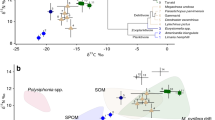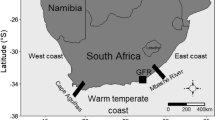Abstract
We characterized the structure and functioning of the food web associated to an intertidal rocky shore in the harbour of Brest (Western Brittany, France), through a seasonal δ13C and δ15N survey. The dominance of benthic-derived organic matter, and particularly resuspended sediment, in the local pool of suspended organic matter, is highlighted. This benthic-derived organic matter dominates the diet of filter-feeders, including a certain degree of selectivity displayed by various taxa belonging to this trophic group. The food web structure appeared very stable temporally, which suggested the dominance of mixed diets, rather than the consumption of pure sources. It was constituted of 4 trophic levels, including a large diversity of predators, likely favoured by the diversity of microhabitats that characterize this intertidal habitat. From our results, the trophic functioning of this peri-urban rocky shore community does not appear functionally simplified as previously reported for other anthropized and/or artificial rocky ecosystems. We suggest that the topological complexity of rocky habitats, including a diversity of microhabitats, might be responsible of the important animal diversity, in spite of the anthropogenic disturbances characterizing this peri-urban area.



Similar content being viewed by others

References
Benedetti-Cecchi L, Chato Osio G (2007) Replication and mitigation of effects of confounding variables in environmental impact assessment: effect of marinas on rocky-shore assemblages. Mar Ecol Prog Ser 334:21–35
Bode A, Alvarez-Ossorio MT, Varela M (2006) Phytoplankton and macrophyte contributions to littoral food webs in the Galician upwelling estimated from stable isotopes. Mar Ecol Prog Ser 318:89–102
Borja A, Franco J, Pérez V (2000) A marine biotic index to establish the ecological quality of soft-bottom benthos within European estuaries and coastal environments. Mar Pollut Bull 40:1100–1114
Bunn SE, Loneragan NR, Kempster MA (1995) Effects of acid washing on stable isotope ratios of C and N in penaeid shrimp and seagrass: implications for food-web studies using multiple stable isotopes. Limnol Oceanogr 40:622–625
Bustamante R, Branch G (1996) The dependance of intertidal consumers on kelp-derived organic matter on the west coast of South Africa. J Exp Mar Biol Ecol 196:1–28
Bustamante R, Branch G, Eekhout S (1995) Maintenance of an exceptional intertidal grazer biomass in South Africa: subsidy by subtidal kelps. Ecology 76:2314–2329
Cabana G, Rasmussen JB (1996) Comparison of aquatic food chains using nitrogen isotopes. Proc Natl Acad Sci USA 93:10844–10847
Carlier A, Riera P, Amouroux J, Bodiou J, Grémare A (2007) Benthic trophic network in the Bay of Banyuls sur Mer (northwest Mediterranean, France): an assessment based on stable carbon and nitrogen isotopes analysis. Est Coast Shelf Sci 72:1–15
Castric-Fey A, Girard-Descatoire A, Gentil F, Davoult D, Dewarumez J-M (1997) Macrobenthos des substrats durs intertidaux et subtidaux. Museum National d’Histoire Naturelle, Paris
Coma R, Ribes M, Gili J-M, Hughes RN (2001) The ultimate opportunists: consumers of seston. Mar Ecol Prog Ser 219:305–308
Davies AJ, Johnson MP, Maggs CA (2008) Subsidy by Ascophyllum nodosum increases growth rate and survivorship of Patella vulgata. Mar Ecol Prog Ser 366:43–48
Duggins DO, Simenstad C, Estes JA (1989) Magnification of secondary production by kelp detritus in coastal marine ecosystems. Science 245:270–273
Dunton KH (2001) δ15N and δ13C measurements of Antarctic Peninsula fauna: trophic relationships and assimilation of benthic seaweeds. Am Zool 41:99–112
Fredriksen S (2003) Food web studies in a Norwegian kelp forest based on stable isotope (d13C and d15N) analysis. Mar Ecol Prog Ser 260:71–81
Fry B, Sherr E (1984) δ13C measurements as indicators of carbon flow in marine and freshwater ecosystems. Contrib Mar Sci 27:13–47
Graham AFRS (1988) Molluscs: Prosobranch and pyramidellid gastropods. In: Kermack DM, Barnes RSK (eds) Synopses of the British Fauna. Leiden, New York, Kobenhavn, Köln, p 662
Grall J, Glémarec M (1997) Using biotic indices to estimate macrobenthic community perturbations in the Bay of Brest. Est Coast Shelf Sci 44A:43–53
Grall J, Le Loc’h F, Guyonnet B, Riera P (2006) Community structure and food web based on stable isotopes (d15N and d13C) analysis of a North Eastern Atlantic maerl bed. J Exp Mar Biol Ecol 338:1–15
Guyonnet B, Grall J, Vincent B (2008) Modified otter trawl legs to reduce damage and mortality of benthic organisms in North East Atlantic fisheries (Bay of Biscay). J Mar Syst 72:2–16
Humborg C, Fennel K, Pastuszka M, Fennel W (2000) A bow model approach for a long-term assessment of estuarine eutrophication, Szczecin lagoon, Southern Baltic. J Mar Syst 25:387–403
Jenkins S, Hartnoll R (2001) Food supply, grazing activities and growth rate in the limpet Patella vulgata L.: a comparison between exposed and sheltered shores. J Exp Mar Biol Ecol 258:123–139
Kaehler S, Pakhomov E, Kalin RM, Davis S (2006) Trophic importance of kelp-derived suspended particulate matter in a through-flow sub-Antarctic system. Mar Ecol Prog Ser 316:17–22
Kang C-K, Choy EJ, Son Y, Lee J-Y, Kim JK, Kim Y, Lee K-S (2008) Food web structure of a restored macroalgal bed in the eastern Korean peninsula determined by C and N stable isotope analyses. Mar Biol 153:1181–1198
Layman CA, Arrington DA, Montana CG, Post D (2007) Can stable isotope ratios provide for community-wide measures of trophic structure? Ecology 88:42–48
Le Pape O, Del Amo Y, Menesguen A, Aminot A, Quequiner B, Treguer P (1996) Resistance of a coastal ecosystem to increasing eutrophic conditions: the Bay of Brest (France), a semi-enclosed zone of Western Europe. Cont Shelf Res 16:1885–1907
Little C, Kitching JA (1996) The biology of rocky shores. Oxford University Press, Oxford
Lorrain A, Paulet Y-M, Chauvaud L, Savoye N, Donval A, Saout C (2002) Differential δ13C and δ15N signatures among scallop tissues: implications for ecology and physiology. J Exp Mar Biol Ecol 275:47–61
Maksymowska D, Richard P, Piekarek-Jankowska H, Riera P (2000) Chemical and isotopic composition of the organic matter sources in the Gulf of Gdansk (Southern Baltic Sea). Est Coast Shelf Sci 51:585–598
McClelland JW, Valiela I (1998) Linking nitrogen in estuarine producers to land-derived sources. Limnol Oceanogr 43:577–585
Peduzzi P (1987) Dietary preferences and carbon absorption by two grazing gastropods, Gibbula umbilicalis (Linné) and Jujubinus striatus (Linné). PSZN I: Mar Ecol 8:359–370
Phillips DL, Gregg JW (2003) Source partitioning using stable isotopes. Coping with too many sources. Oecologia 136:261–269
Pinnegar JK, Polunin N (1999) Differential fractionation of δ13C and δ15N among fish tissues: implications for the study of trophic structure. Func Ecol 13:225–231
Rau GH, Teyssie J-L, Rassoulzadegan F, Fowler SW (1990) 13C/12C and 15N/14N variations among size-fractionated marine particles: implications for their origin and trophic relationships. Mar Ecol Prog Ser 59:33–38
Raven JA, Johnston AM, Kübler JE, Korb R, McInroy SG, Handley LL, Scrimgeour CM, Walker DI, Beardall J, Vanderklift MA, Fredriksen S, Dunton KH (2002) Mechanistic interpretation of carbon isotope discrimination by marine macroalgae and seagrasses. Func Plant Biol 29:355–378
Riera P, Hubas C (2003) Trophic ecology of nematodes from various microhabitats of the Roscoff Aber Bay (France): importance of stranded macroalgae evidenced through d13C and d15N. Mar Ecol Prog Ser 260:151–159
Riera P, Richard P (1997) Temporal variations of δ13C in particulate organic matter and oyster Crassostrea gigas in Marennes-Oléron Bay (France): effect of freshwater inflow. Mar Ecol Prog Ser 147:105–115
Riera P, Stal LJ, Nieuwenhuize J (2000) Heavy δ15N in intertidal benthic algae and invertebrates in the Scheldt estuary (The Netherlands): effects of river nitrogen inputs. Est Coast Shelf Sci 51:365–372
Riera P, Stal LJ, Nieuwenhuize J (2004) Utilization of food sources by invertebrates in a man-made intertidal ecosystem (Westerschelde, the Netherlands): a δ13C and δ15N study. J Mar Biol Ass U K 84:323–326
Riera P, Escaravage C, Leroux C (2009) Trophic ecology of the rocky shore community associated to the Ascophyllum nodosum zone (Roscoff, France): a δ13C vs δ15N investigation. Est Coast Shelf Sci 81:143–148
Rooney N, McCann KS, Gellner G, Moore JC (2006) Structural asymmetry and the stability of diverse food webs. Nature 442:265–269
Sarà G, De Pirro M, Romano C, Rumolo P, Sprovieri M, Mazzola A (2007) Sources of organic matter for intertidal consumers on Ascophyllum-shores (SW Iceland): a multi-stable isotope approach. Helgol Mar Res 61:297–302
Schaal G, Riera P, Leroux C (2008) Trophic coupling between two adjacent benthic food webs within a man-made intertidal area: A stable isotopes evidence. Est Coast Shelf Sci 77:523–534
Schaal G, Riera P, Leroux C (2009) Trophic ecology in a Northern Brittany (Batz Island, France) kelp (Laminaria digitata) forest, as investigated through stable isotope and chemical assays. J Sea Res (in press)
Steinarsdottir MB, Ingolfsson A, Olafsson E (2009) Trophic relationships on a fucoid shore in south-western Iceland as revealed by stable isotope analyses, laboratory experiments, field observations and gut analyses. J Sea Res 61:206–215
Takai N, Yorozu A, Tanimoto T, Hoshika A, Yoshihara K (2004) Transport pathways of microphytobenthos-originating organic carbon in the food web of an exposed hard bottom shore in the Seto Inland Sea, Japan. Mar Ecol Prog Ser 284:97–108
Tieszen LL, Boutton TW, Tesdahl KG, Slade NA (1983) Fractionation and turnover of stable carbon isotopes in animal tissues: implications for δ13C analysis of diet. Oecologia 57:32–37
Vanderklift MA, Ponsard S (2003) Sources of variation in consumer-diet δ15N enrichment: a meta-analysis. Oecologia 136:169–182
Vander Zanden MJ, Rasmussen JB (2001) Variation in δ15N and δ13C trophic fractionation. Implications for aquatic food web studies. Limnol Oceanogr 46:2061–2066
Acknowledgments
This work is partly funded by the ANR (National Research Agency) ECOKELP. G. Schaal is funded by a French Ministry of Research and Technologies grant. The authors thank Erwan Amice, Caroline Broudin, Benjamin Guyonnet, Robert Marc and Renaud Michel for their valuable help during field sampling. The authors would like to thank Dr Fabio Bulleri and three anonymous reviewers for their helpful comments that greatly contributed to improve this manuscript. We also greatly thank Dr L. M. -L. J. Noël for improving the english.
Author information
Authors and Affiliations
Corresponding author
Additional information
Communicated by F. Bulleri.
Rights and permissions
About this article
Cite this article
Schaal, G., Riera, P., Leroux, C. et al. A seasonal stable isotope survey of the food web associated to a peri-urban rocky shore. Mar Biol 157, 283–294 (2010). https://doi.org/10.1007/s00227-009-1316-9
Received:
Accepted:
Published:
Issue Date:
DOI: https://doi.org/10.1007/s00227-009-1316-9



